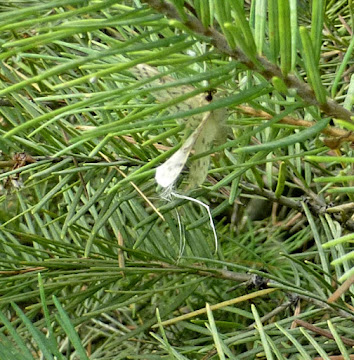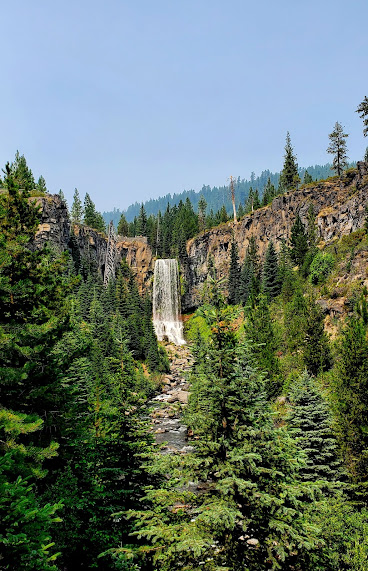Sandra and I feel really lucky that our son and his lovely wife enticed us into a relationship with Dougan Falls. It is relatively close to Vancouver and it is an idyllic spot replete with an extraordinarily pretty waterfall. Combined with a variety of host plants, this area is also a good habitat for a variety of butterflies.
On our first three visits we concentrated on the road that leads out of the car park and up the Washougal. Even in August this upper portion of the Washougal had enough water to service the falls and provide a rushing stream. We arrived mid-week a little before 10 AM, it was overcast and the the car, smart fellow that it is, informed us that the outside temperature was a cool but comfortable 60 degrees. From the falls it is 14 miles to actual headwaters of the Washougal. If one is persistent, he can drive an additional ten miles before the road stops, leaving the last few miles of the dwindling river to those afoot.
We have never made it further than four miles from the car park and it was at that spot that we turned around. We stopped halfway between Bender Falls and Naked Falls at a spot where we have seen cars parked in the past.
The gravel road up the Washougal is notable for lots of signs telling you exactly what pass you need to park in a given spot or, more commonly, that you are not permitted to park at all. Why this should be so, what sort of mischief has occurred, is a mystery. However, it is my current opinion that there is no constabulary authorized to ticket your car, but that some land owner is in cahoots with a towing company and you are in jeopardy of being towed only if you are away from your vehicle for hours, like if you are camping overnight.
 |
| Pyralidae moth, Naked Falls, August 2021 |
Parked for a short stay, I got out and walked down the trail in the direction of the stream. Somewhat to my surprise, about fifty feet down the trail I spotted a young woman bearing an armload of camping gear coming in my direction. We said hello and I got out of her way. She warned me that there was a dog further down the trail that would bark but was otherwise friendly. By which I assume she meant it was relatively unlikely to bite. And this, to quote the bard, "is a consummation devoutly to be wished."
Having disposed of her sleeping bag, maybe even her tent, she was on her way back to camp when I asked her if she had seen an butterflies. She allowed that she had seen none there but the previous day on a nearby fork leading uphill, they had seen some orange and black butterflies. A few steps later, she found a tiny white butterfly and left me to my photographic efforts.
 |
| The Pyralidae moth shows a little leg. |
Two days earlier, my lovely wife and I had attended a seminar at Best Buy, where a photo salesman, who allowed that he was a good amateur photographer, showed me their SLRs and confirmed that if I wanted to go that route for taking pictures of butterflies, I was going to be into it for more than a thousand quid. Further, this expensive batch of electronic wizardry might not be up to fierce rainstorm.
We wandered over to the point and shoots and I probed him to discover just how he might get the most out of one of these, which although fifteen years younger, approximates the camera we have been using this summer.
Following the symposium I went home and made kissy face with my aging Lumix. As i approched this miniscule lepidopteran, I knew this was the moment that we would take the new strategy into battle.
Here we had a very small insect with a wing span about a centimeter or so. What you see are my best results, massaged by the photo processor. Even after a couple glasses of cheap chardonnay I could not find his pallid visage in my field guides. Daniel Rubinoff to the Rescue tells us that this is a moth of the family Pyralidae. He was unable to put a species name on it (apparently it is a big genus) but allowed that, being a moth, it would not be in any butterfly book. This also explains why, no matter how hard you look, you won't see any antennae.
 |
| Dougan Creek, August 2021 |
Soon enough we were back to the falls, where we decided to drive out the other way, past the entrance to Dougan Falls Campground. We followed this well graded gravel road uphill for about two miles, at which point it makes a button hook turn to the left and continues uphill. For this first two miles the road hugs Dougan Creek. While much smaller than the Washougal, we had glimpses of a pleasant little stream cascading over and around boulders, with forest extending to the winter banks on each side. Most notably, this must all be state or federal land, for there is not a single sign instructing you to buy a permit to park or to avoid trespassing all together.
At the sharp turn, a family had pitched their tent on the edge of the road. With the whole forest to choose from, this struck me as an odd choice for a camp site. I suppose the road is not heavily used but Google maps tells us that it continues uphill for several miles and connects to other roads in the forest.
We did not continue up hill, but chose that point to turn around. As we did so, a Lorquin's Admiral flew right in front of us and into the forest beside the creek. We stopped to check it out, but he was long gone. And so we drove back down half a mile or so. What had been a cool, overcast day was getting sunnier by the minute. I had spied a turn out with good access to the creek, where we parked in the shade, put the windows down and enjoyed the quiet forest and the babbling creek as we had an early lunch.
 |
| Lorquin's Admiral "Wings Up" Resting Position |
After lunch I descended a gentle twenty feet to the creek bed. The boulder strewn bed at this point spanned at least 100 feet. One must assume that Dougan Creek fills this expanse with rushing water in the spring. This being late August, one could just about hop from boulder to boulder and thus cross the creek if she were so disposed. It was so verdant and peaceful, the merry creek swirling gently from pool to pool. I watched a few water boatmen plying their trade in one of the pools of clear mountain water and then returned to the car, coaxing Sandra down into this bit of paradise.
We spent about half an our exploring pools, stepping from rock to rock. And also seeing some butterflies. A small butterfly was working the branches of an alder on the far bank; even with the binoculars I could not identify him. In a bit an sulfur clouded butterfly passed close by and then fluttered his way upstream. This butterfly is much larger than other yellowish gray butterflies found in our area and so it can be identified on the wing.
And then there were the Lorquin's Admirals. My first good shot involved a butterfly with a chip out of his wing. He sat patiently in the moss on a boulder, his wings up in resting position. I was able to get close and get this nice shot of the ventral surface of this complex insect.
 |
| Lorquin's Admiral, Dougan Creek August 2021 |
The second shot was even better. An admiral flew in and settled on a pair of men's socks that some thoughtless person had left in the creek bed. Although the idea of littering in paradise is an anathema to me, it turns out that such a decaying bit of underwear may hold significant attraction for these chemically sensitive insects. When I showed the picture to Daniel Rubinoff he replied that butterflies are frequently found on "stinky stuff.". I still deplore the littering, but I love these pictures.
The waterfall at Dougan Falls is nice, but I can hardly wait to take the journey back up to Dougan Creek. Maybe next time we'll take a grandchild. What a fantastic place to take some grandparent pictures.
jeff
Our mentor, Daniel Rubinoff has just published a book. He was a bit sheepish about telling me about it, but why should he be? Every time I corresponded with Jack Randall about a tropical reef fish sighting he was kind enough to write back, but always included information on one of his many publications that should be added to my library. So here is the name of Daniel's book and a link to
purchase from Amazon.Field Guide to California Insects
https://www.amazon.com/Field-Guide-California-Insects-Natural/dp/0520288742/ref=sr_1_1?dchild=1&keywords=california+insects&qid=1630024161&sr=8-1

















